History of the Bible - Lesson 13
Further Englishing of the Bible
History of the Bible - Lesson 13
Further Englishing of the Bible
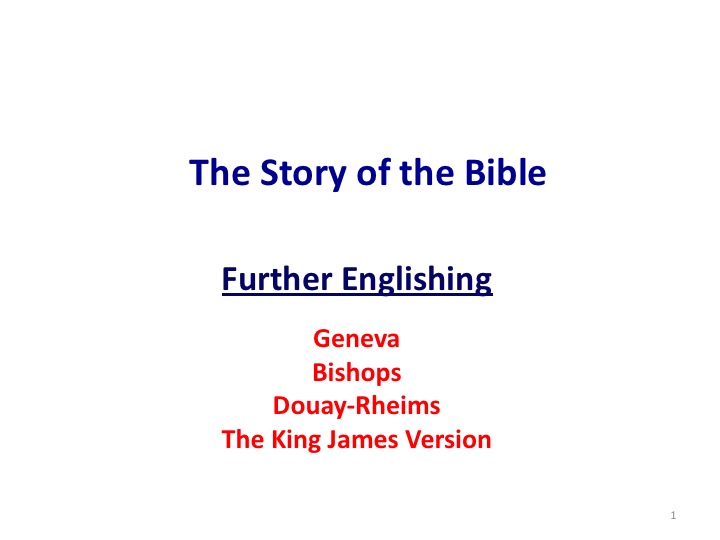
Further Englishing
We return to the subject of translating the Bible into the people’s languages and will continue the discussion we studied on “Englishing the Bible”.
We are calling this “Further Englishing”, and I will begin by explaining that I am aware that Englishing is probably not a real word, but I kind of like it and so will continue to use it.
After the English Bibles we discussed last week, beginning with John Wycliff’s middle English translation done in in the 14th century, and I will review that list for you again in slide three, we will move forward thru four more English Bibles, concluding with the famous and important King James Version. In fact most of today’s discussion will be about the King James.
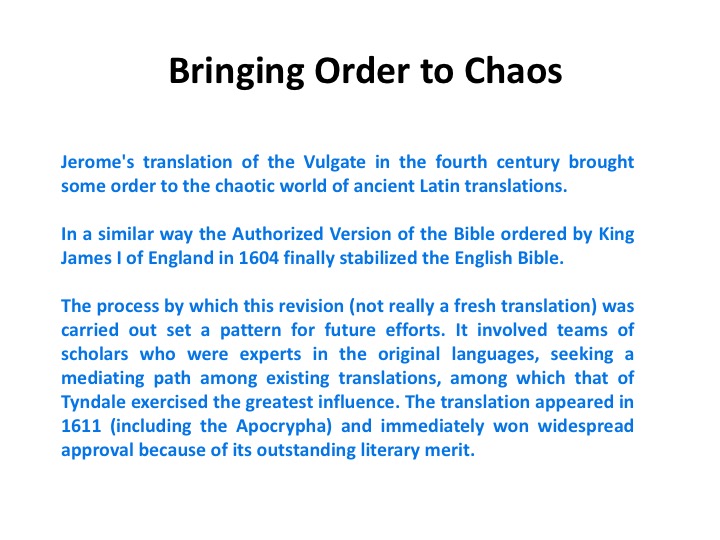
Bringing Order to Chaos
Jerome's translation of the Vulgate in the fourth century brought some order to the chaotic world of ancient Latin translations.
In a similar way the Authorized Version of the Bible ordered by King James I of England in 1604 finally stabilized the English Bible.
The process by which this revision (not really a fresh translation) was carried out set a pattern for future efforts. It involved teams of scholars who were experts in the original languages, seeking a mediating path among existing translations, among which that of Tyndale exercised the greatest influence. The translation appeared in 1611 (including the Apocrypha) and immediately won widespread approval because of its outstanding literary merit.
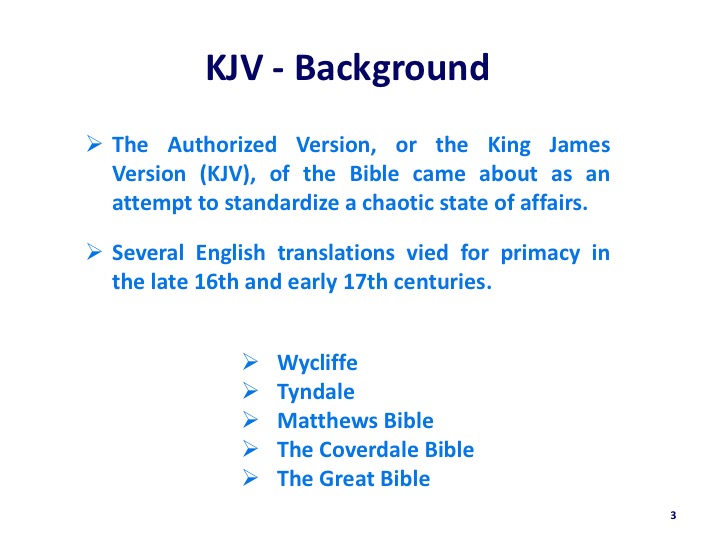
KJV – Background
The Authorized Version, or the King James Version (KJV), of the Bible came about as an attempt to standardize a chaotic state of affairs.
Several English translations vied for primacy in the late 16th and early 17th centuries.
Wycliffe; Tyndale; Matthews Bible; The Coverdale Bible; The Great Bible
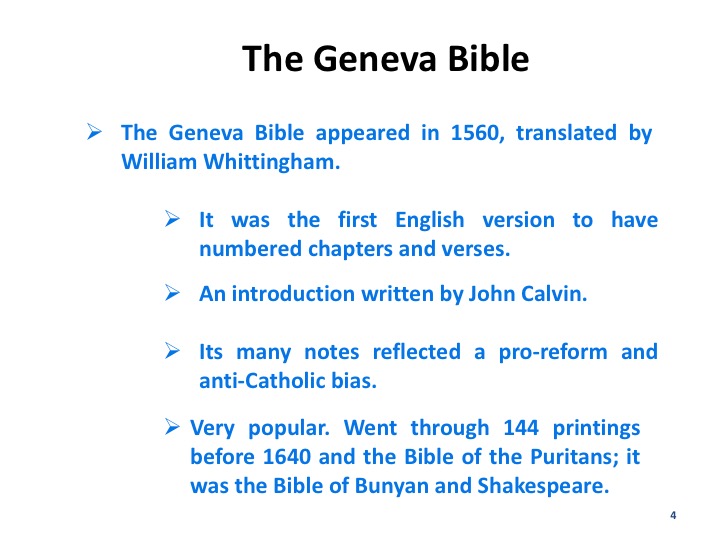
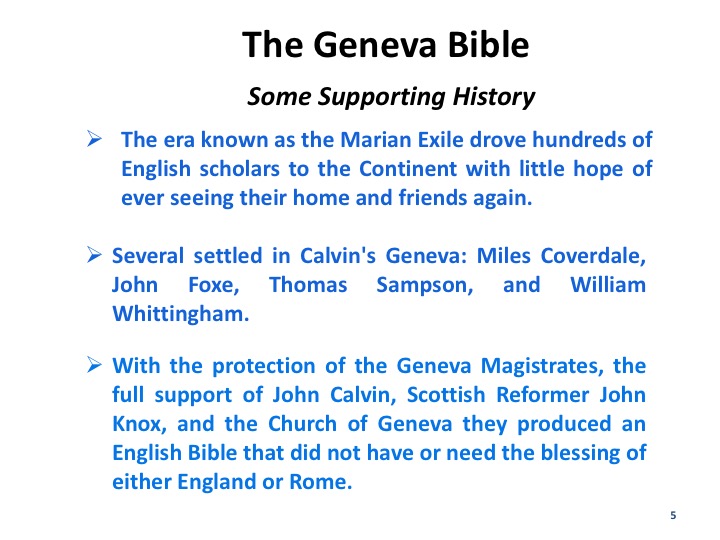
The era known as the Marian Exile drove hundreds of English scholars to the Continent with little hope of ever seeing their home and friends again. A number of English Protestant scholars settled in Calvin's Geneva: Miles Coverdale, John Foxe, Thomas Sampson, and William Whittingham, among others. With the protection of the Genevan civil authorities and the support of John Calvin and the Scottish Reformer John Knox, the Church of Geneva determined to produce an English Bible without the need for the imprimatur of either England or Rome - the Geneva Bible.
The Geneva translators produced a revised New Testament in English in 1557 that was essentially a revision of Tyndale's revised and corrected 1534 edition. Much of the work was done by William Whittingham, the brother-in-law of John Calvin. The Geneva New Testament was barely off the press when work began on a revision of the entire Bible, a process that took more than two years. The new translation was checked with Theodore Beza's earlier work and the Greek text. In 1560 a complete revised Bible was published, translated according to the Hebrew and Greek, and conferred with the best translations in divers languages, and dedicated to Queen Elizabeth I. After the death of Mary, Elizabeth was crowned queen in 1558, once again moving England toward Protestantism. The Geneva Bible was finally printed in England in 1575 only after the death of Archbishop Matthew Parker, editor of the Bishop's Bible.
The Geneva Bible is an example of a bible whose actual translation reflected ecclesial positions. The greek word presbyter was translated as elder, not as priest, as it had been in earlier translations.
While other English translations failed to capture the hearts of the reading public, the Geneva Bible was instantly popular. Between 1560 and 1644 at least 144 editions appeared. For forty years after the publication of the King James Bible, the Geneva Bible continued to be the Bible of the home. Oliver Cromwell used extracts from the Geneva Bible for his Soldier's Pocket Bible which he issued to the army.
In 1620 the Pilgrims arrived at Plymouth with their Bibles and a conviction derived from those Bibles of establishing a new nation. The Bible was not the King James Version. When James I became king of England in 1603, there were two translations of the Bible in use; the Geneva Bible was the most popular, and the Bishops' Bible was used for reading in churches.
King James disapproved of the Geneva Bible because of its Calvinistic leanings. Remember, he was Anglican, not Calvinist. He also frowned on what he considered to be seditious marginal notes on key political texts. A marginal note for Exodus 1:9 indicated that the Hebrew midwives were correct in disobeying the Egyptian king's orders. The King James Version of the Bible grew out of the king's distaste for these brief but potent doctrinal commentaries that might suggest that it was OK to disobey your king. He considered the marginal notes to be a political threat to his kingdom.
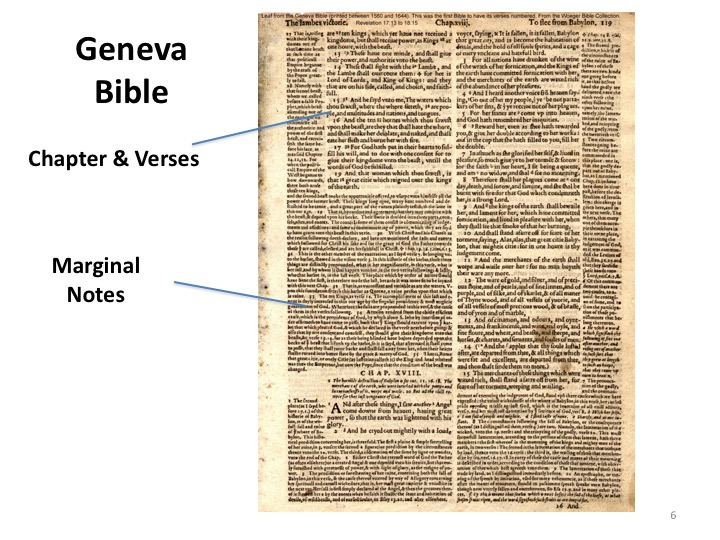
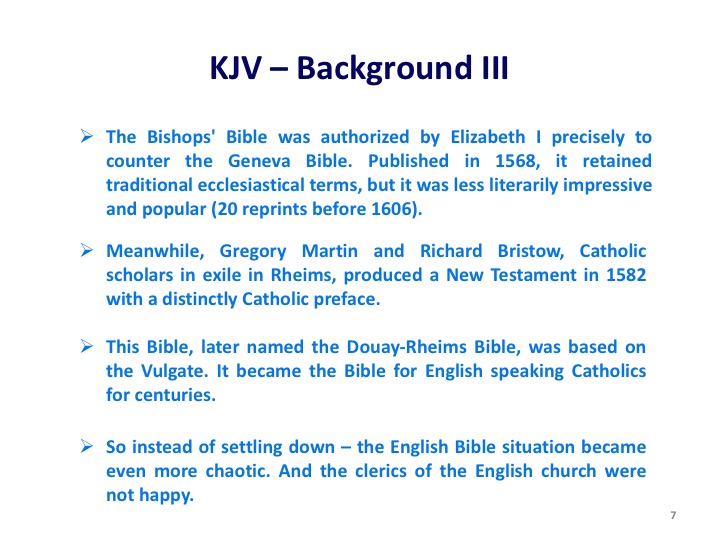
KJV – Background III
The Bishops' Bible was authorized by Elizabeth I precisely to counter the Geneva Bible. Published in 1568, it retained traditional ecclesiastical terms, but it was less literarily impressive and popular (20 reprints before 1606).
Meanwhile, Gregory Martin and Richard Bristow, Catholic scholars in exile in Rheims, produced a New Testament in 1582 with a distinctly Catholic preface.
This Bible, later named the Douay-Rheims Bible, was based on the Vulgate. It became the Bible for English speaking Catholics for centuries.
So instead of settling down – the English Bible situation became even more chaotic. And the clerics of the English church were not happy.
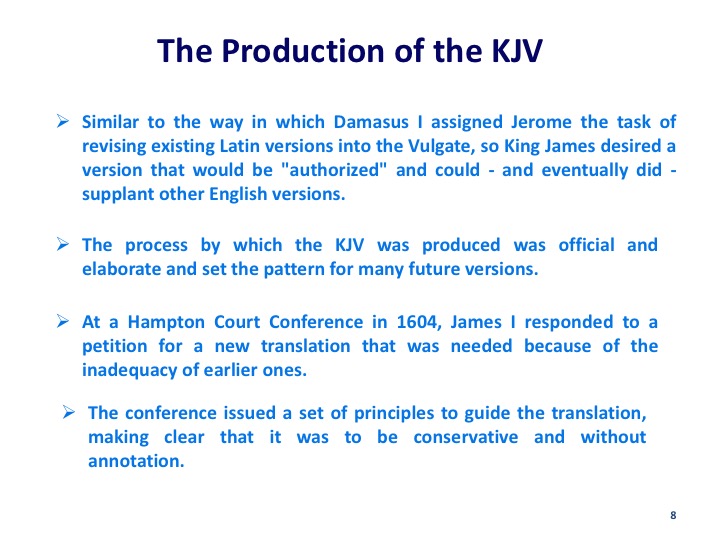
The Production of the KJV
Similar to the way in which Damasus I assigned Jerome the task of revising existing Latin versions into the Vulgate, so King James desired a version that would be "authorized" and could - and eventually did -supplant other English versions.
The process by which the KJV was produced was official and elaborate and set the pattern for many future versions.
At a Hampton Court Conference in 1604, James I responded to a petition for a new translation that was needed because of the inadequacy of earlier ones.
The conference issued a set of principles to guide the translation, making clear that it was to be conservative and without annotation.
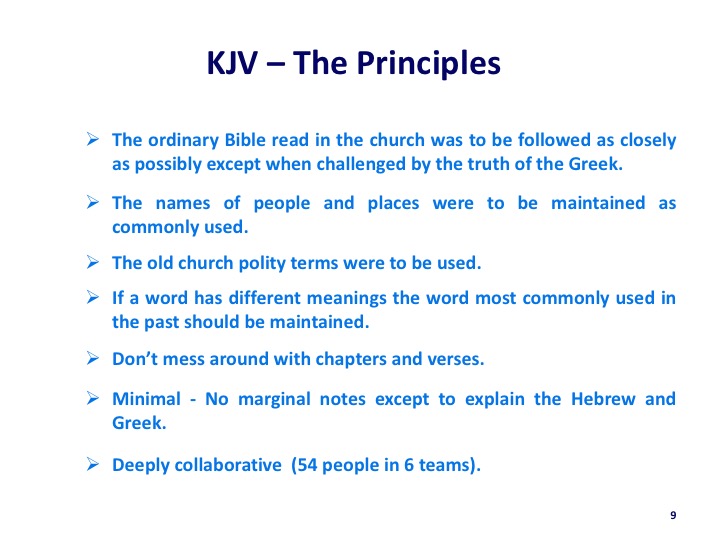
KJV – The Principles
The ordinary Bible read in the church was to be followed as closely as possibly except when challenged by the truth of the Greek.
The names of people and places were to be maintained as commonly used.
The old church polity terms were to be used.
If a word has different meanings the word most commonly used in the past should be maintained.
Don’t mess around with chapters and verses
Minimal - No marginal notes except to explain the Hebrew and Greek.
Deeply collaborative (54 people in 6 teams)
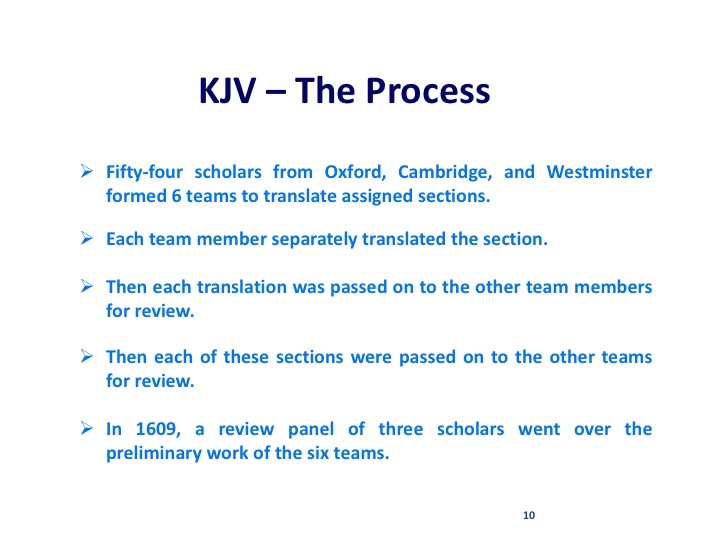
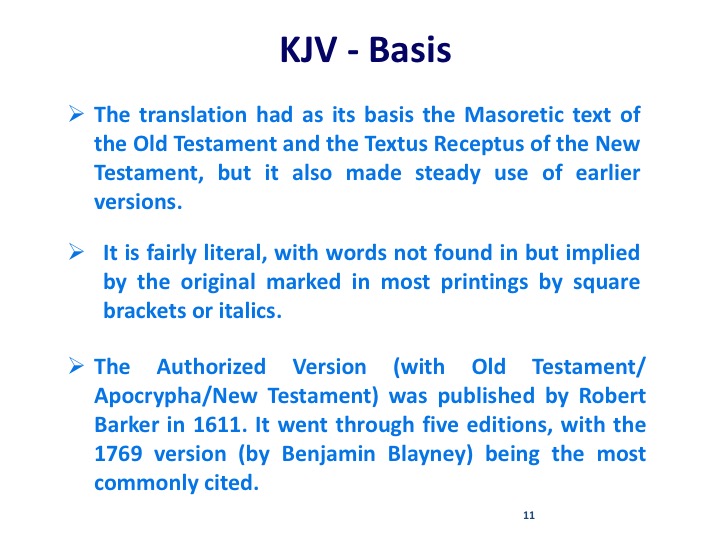
KJV - Basis
The translation had as its basis the Masoretic text of the Old Testament and the Textus Receptus of the New Testament, but it also made steady use of earlier versions.
The Textus Receptus (“received text”) was the 16th century version of a scholars Bible, prepared for translators. It was a combination of the Comutensian Polyglot, prepared in Spain, the Greek text prepared by Erasmus of Rotterdam, an then revised by the scholar Theodore Beza.
It is fairly literal, with words not found in but implied by the original marked in most printings by square brackets or italics.
The Authorized Version (with Old Testament/ Apocrypha/New Testament) was published by Robert Barker in 1611. It went through five editions, with the 1769 version (by Benjamin Blayney) being the most commonly cited.
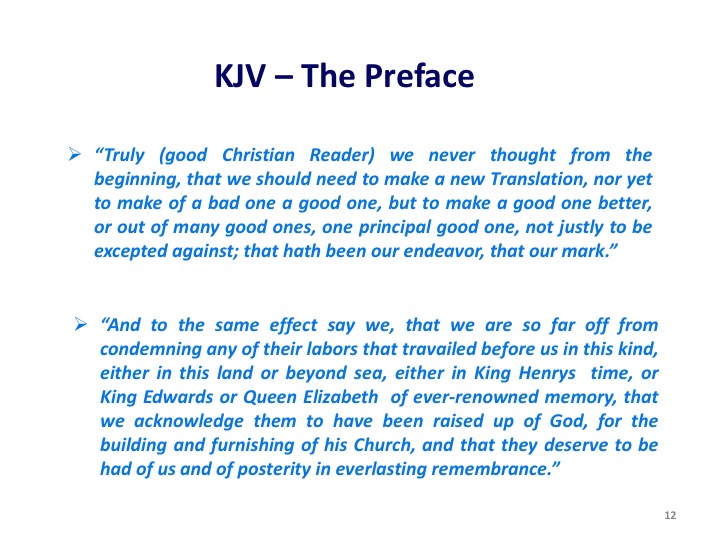
KJV – The Preface
“Truly (good Christian Reader) we never thought from the beginning, that we should need to make a new Translation, nor yet to make of a bad one a good one, but to make a good one better, or out of many good ones, one principal good one, not justly to be excepted against; that hath been our endeavor, that our mark.”
“And to the same effect say we, that we are so far off from condemning any of their labors that travailed before us in this kind, either in this land or beyond sea, either in King Henry’s time, or King Edwards or Queen Elizabeth of ever-renowned memory, that we acknowledge them to have been raised up of God, for the building and furnishing of his Church, and that they deserve to be had of us and of posterity in everlasting remembrance.”
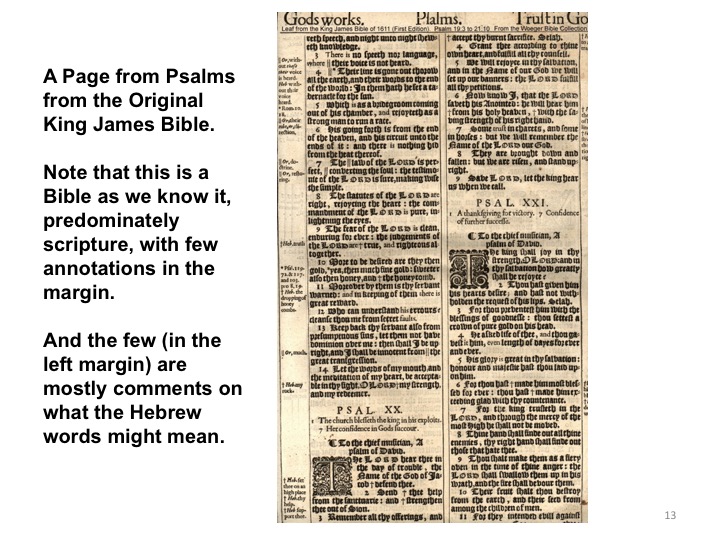
A Page from Psalms from the Original King James Bible.
Note that this is a Bible as we know it, predominately scripture, with few annotations in the margin.
And the few (in the left margin) are mostly comments on what the Hebrew words might mean.
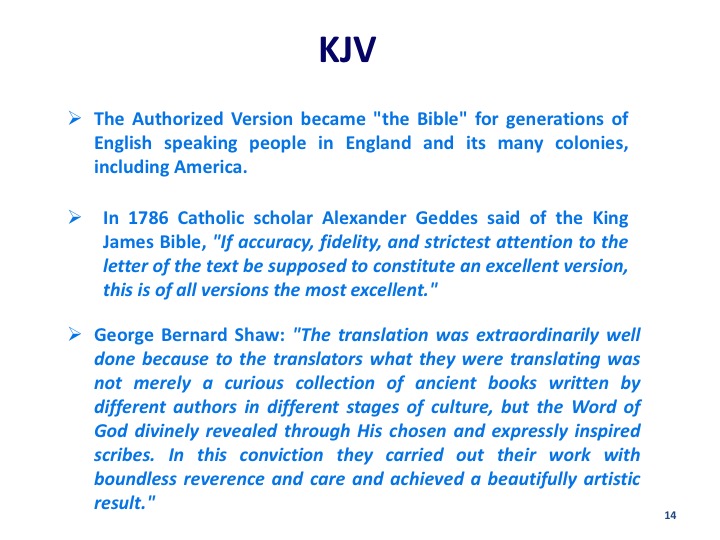
Praise for the KJV
The Authorized Version became "the Bible" for generations of English speaking people in England and its many colonies, including America.
In 1786 Catholic scholar Alexander Geddes said of the King James Bible, "If accuracy, fidelity, and strictest attention to the letter of the text be supposed to constitute an excellent version, this is of all versions the most excellent."
George Bernard Shaw: "The translation was extraordinarily well done because to the translators what they were translating was not merely a curious collection of ancient books written by different authors in different stages of culture, but the Word of God divinely revealed through His chosen and expressly inspired scribes. In this conviction they carried out their work with boundless reverence and care and achieved a beautifully artistic result."
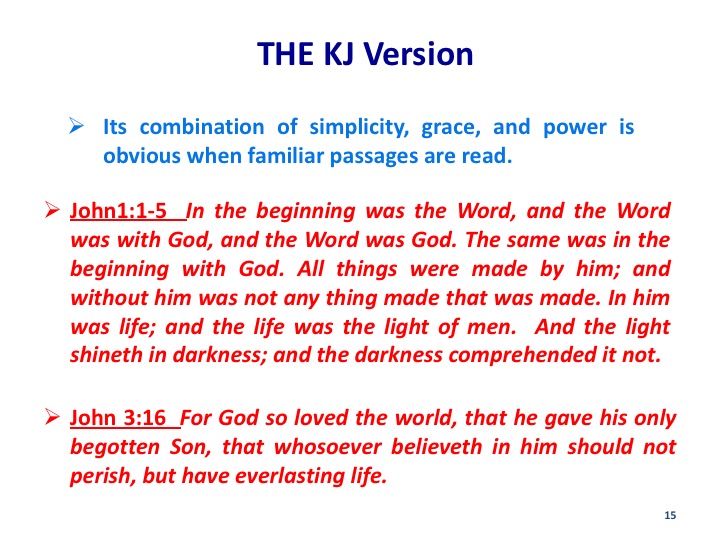
THE KJ Version
Its combination of simplicity, grace, and power is obvious when familiar passages are read.
John1:1-5 In the beginning was the Word, and the Word was with God, and the Word was God. The same was in the beginning with God. All things were made by him; and without him was not any thing made that was made. In him was life; and the life was the light of men. And the light shineth in darkness; and the darkness comprehended it not.
John 3:16 For God so loved the world, that he gave his only begotten Son, that whosoever believeth in him should not perish, but have everlasting life.
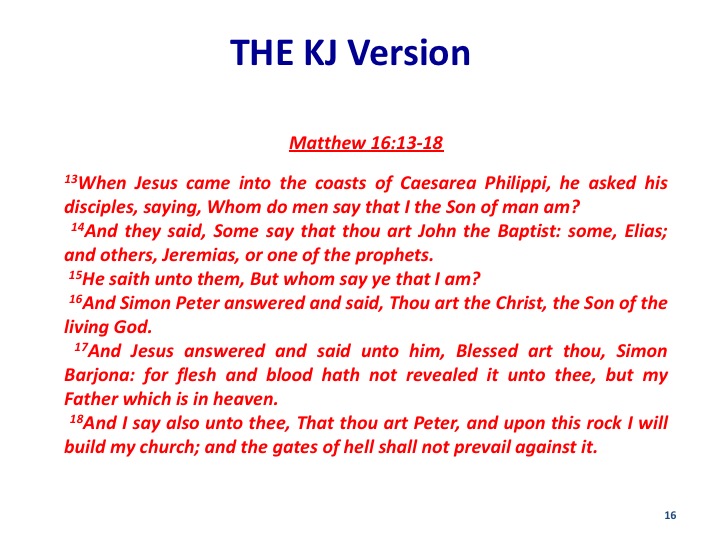
THE KJ Version
Matthew 16:13-18
13 When Jesus came into the coasts of Caesarea Philippi, he asked his disciples, saying, Whom do men say that I the Son of man am?
14 And they said, Some say that thou art John the Baptist: some, Elias; and others, Jeremias, or one of the prophets.
15 He saith unto them, But whom say ye that I am?
16 And Simon Peter answered and said, Thou art the Christ, the Son of the living God.
17 And Jesus answered and said unto him, Blessed art thou, Simon Barjona: for flesh and blood hath not revealed it unto thee, but my Father which is in heaven.
18 And I say also unto thee, That thou art Peter, and upon this rock I will build my church; and the gates of hell shall not prevail against it.
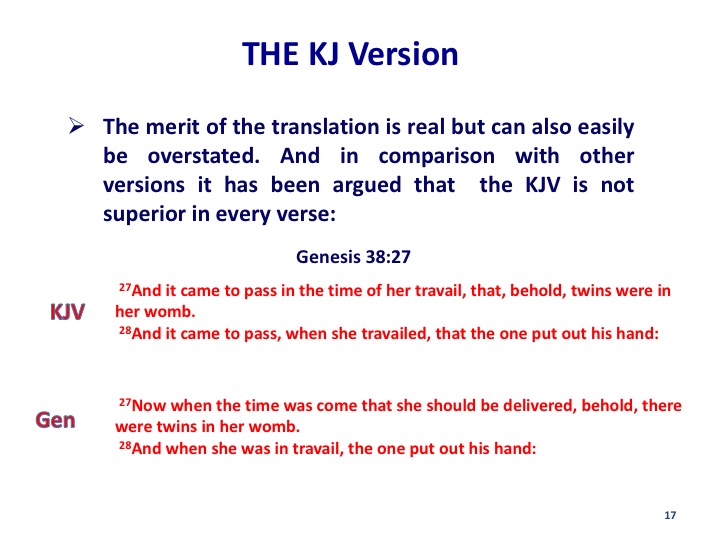
THE KJ Version
The merit of the translation is real but can also easily be overstated. And in comparison with other versions it has been argued that the KJV is not superior in every verse:
Genesis 38:27
KJV
27 And it came to pass in the time of her travail, that, behold, twins were in her womb.
28 And it came to pass, when she travailed, that the one put out his hand:
Geneva
27 Now when the time was come that she should be delivered, behold, there were twins in her womb.
28 And when she was in travail, the one put out his hand:
Cleaner and simpler.
In a famous essay C. S Lewis pointed out how difficult it is to show that it is the KJV that is influencing the English language so much, or is it just all the versions – biblical English in general.
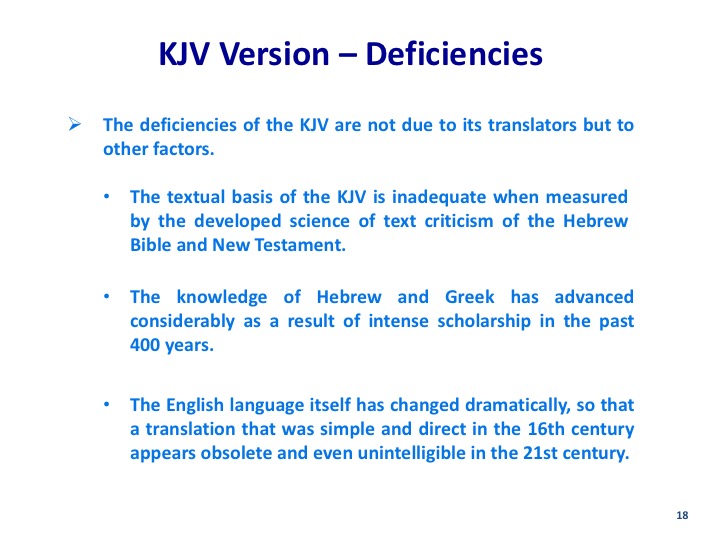
KJV Version – Deficiencies
The deficiencies of the KJV are not due to its translators but to other factors.
The textual basis of the KJV is inadequate when measured by the developed science of text criticism of the Hebrew Bible and New Testament.
Textus Receptus – is based on very few manuscripts – and they tend to be recent. By comparison over the last three centuries scholars have gathered over 5000 versions of the Greek text – many from the 3rd, 4th, and 5th, centuries and even a few from the 2nd century – much closer to the originals.
The knowledge of Hebrew and Greek has advanced considerably as a result of intense scholarship in the past 400 years.
The English language itself has changed dramatically, so that a translation that was simple and direct in the 16th century appears obsolete and even unintelligible in the 21st century. This is a fact that is hidden from us by our constant use of the KJV. And when we use it we are seldom asked to interpret what we just read- Can you parse that sentence?
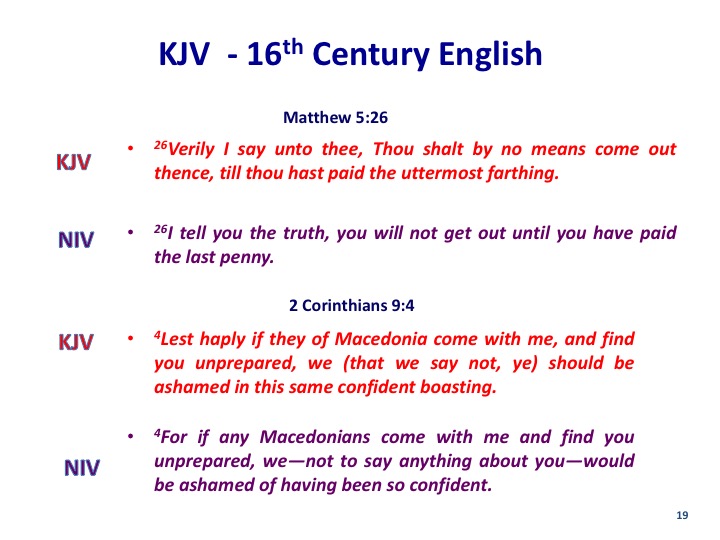
KJV - 16th Century English
Matthew 5:26
KJV
26 Verily I say unto thee, Thou shalt by no means come out thence, till thou hast paid the uttermost farthing.
This is a simple verse from the sermon on the mount – it has 20 words – 8 of which are no longer in common use. We don’t speak of uttermost, we don’t know what a farthing is. And we don’t use thee, thence, or hast.
NIV
26 I tell you the truth, you will not get out until you have paid the last penny.
2 Corinthians 9:4
KJV
4 Lest haply if they of Macedonia come with me, and find you unprepared, we (that we say not, ye) should be ashamed in this same confident boasting.
NIV
4 For if any Macedonians come with me and find you unprepared, we - not to say anything about you - would be ashamed of having been so confident.
Still a little awkward, but more understandable.
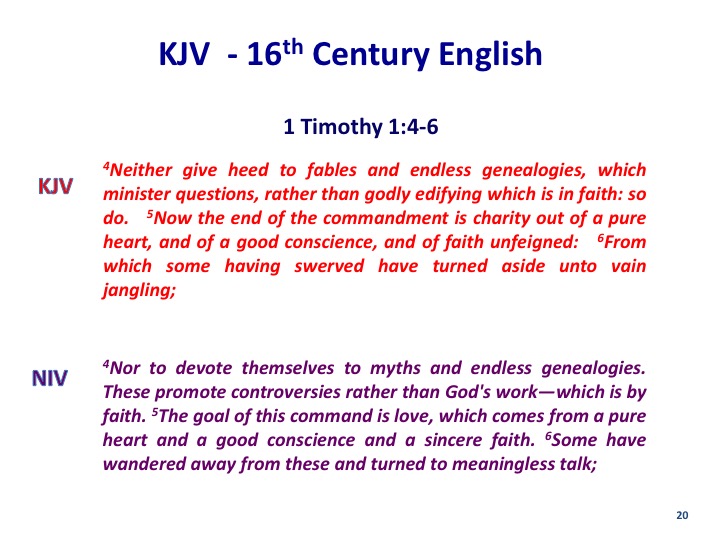
KJV - 16th Century English
1 Timothy 1:4-6
KJV
4 Neither give heed to fables and endless genealogies, which minister questions, rather than godly edifying which is in faith: so do. 5 Now the end of the commandment is charity out of a pure heart, and of a good conscience, and of faith unfeigned: 6 From which some having swerved have turned aside unto vain jangling;
Now I submit that vain jangling is a wonderful phrase – as is faith unfeigned - but some of us might be challenged to define what they actually mean. It also uses the word minister in a way we do not use it today. And we do not talk of charity today – except as a form of benevolence giving of financial assistance to the poor, or sick or disadvantaged. And godly edifying may make good church talk, but edification is today a fairly weak word and is problematic on more than one count.
NIV
4 Nor to devote themselves to myths and endless genealogies. These promote controversies rather than God's work—which is by faith. 5 The goal of this command is love, which comes from a pure heart and a good conscience and a sincere faith. 6 Some have wandered away from these and turned to meaningless talk;
So the KJV is a magnificent monument to 16th century translation.
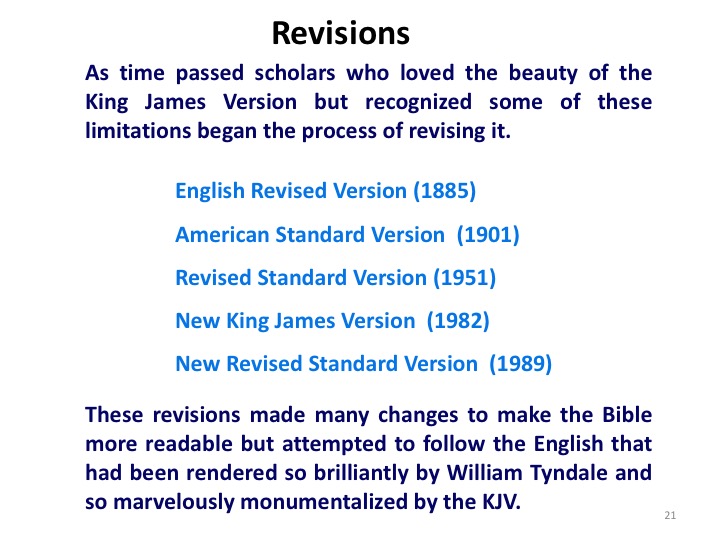
Revisions
As time passed scholars who loved the beauty of the King James Version but recognized some of these limitations began the process of revising it.
o English Revised Version (1885)
o American Standard Version (1901)
o Revised Standard Version (1951)
o New King James Version (1982)
o New Revised Standard Version (1989)
English Revised Version (1885) Westcott and Hort. It Began use of earlier (than the Textus Receptus) Greek sources. First post KJV bible to gain wide acceptance. It was the first and remains the only officially authorized and recognized revision of the King James Bible.
American Standard Version (1901) An American revision of the English Revised.
Revised Standard Version (1951) Aimed to be a readable and literally accurate modern English translation of the Bible. The intention was not only to create a clearer version of the Bible for the English-speaking church, but also to "preserve all that is best in the English Bible as it has been known and used through the centuries" and "to put the message of the Bible in simple, enduring words that are worthy to stand in the great Tyndale-King James tradition.” But the RSV represented a complete break with the Textus Receptus.
New King James Version (1982) The aim of its translators was to update the vocabulary and grammar of the King James Version, while preserving the classic style and beauty of the 1611 version. But maintaining the Textus Receptus as the New Testament source.
New Revised Standard Version (1989) A thorough revision of the Revised Standard Version (RSV). Takes dead sea scrolls into account. Also available in a Catholic edition.
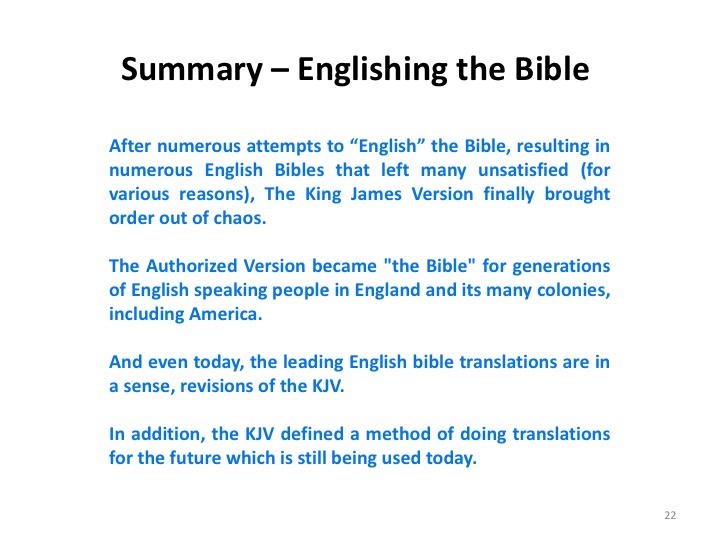
Summary – Englishing the Bible
After numerous attempts to “English” the Bible, resulting in numerous English Bibles that left many unsatisfied (for various reasons), The King James Version finally brought order out of chaos.
The Authorized Version became "the Bible" for generations of English speaking people in England and its many colonies, including America.
And even today, the leading English bible translations are in a sense, revisions of the KJV.
In addition, the KJV defined a method of doing translations for the future which is still being used today.
And Next Week - we examine the great search for early biblical manuscripts all over the Mediterranean basin, leading to the development of a critical text for the New Testament.